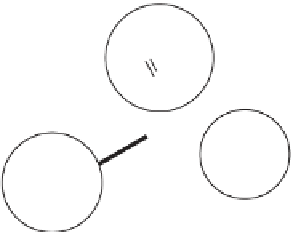Biomedical Engineering Reference
In-Depth Information
FIGURE 6.1
Cyclohexane-based thyrotropin-releasing hormone mimetic.
cyclohexane scaffold [6]. In this case, the cyclohexane ring replaces the peptide
backbone, and the three functional groups that constitute the pharmacophore are
placed on the scaffold with the same spatial orientation of amino acid side chains
found in TRH (Figure 6.1). Moreover, by conferring additional rigidity on the system,
cyclohexane determines an increase in the biological activity, although the side-chain
rotation is still maintained.
6.3 EARLY COMBINATORIAL APPROACHES TO
PEPTIDOMIMETIC SCAFFOLDS
Several reports on application of the concepts of combinatorial chemistry in the
field of peptidomimetics appeared in 1996, in an effort to develop molecules resem-
bling peptide pharmacophores [11], including the generation of peptidomimetics
containing the phosphinic group as a transition-state isostere in neurolysin inhibitors
[11b] and the development of a library of molecules as dipeptide isosteres to expand
the side-chain functionality of the central core scaffold through consecutive amide
alkylations [11d]. Successively, many research groups turned their attention to the
generation of scaffold-based chemical libraries possessing a more “drug-like” pro-
file, still taking into account amino acid moieties as a source of chemical diversity.
Accordingly, early combinatorial libraries were conceived around a readily available





















































































